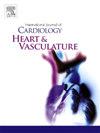经股动脉 TAVI 的微创全血管内 (LITE) 技术的可行性、安全性和临床影响:1000例患者的单中心经验
IF 2.5
Q2 CARDIAC & CARDIOVASCULAR SYSTEMS
引用次数: 0
摘要
背景经股动脉(TF)是 TAVI 的主要入路。尽管开展 TF-TAVI 有多种技术策略(起搏方式、二级动脉通路、主通路穿刺等),但最佳技术尚未得到认可。Aims在本研究中,我们使用 VARC-3 结果定义,评估了系统使用 LITE-TAVI 在可行性、安全性和主通路并发症管理方面的影响。Methods自 2017 年以来,我院已开发出用于 TF-TAVI 的微创全血管内(LITE)技术。主要内容包括:使用血管造影-导丝超声引导进行精确的 TAVI 入路穿刺;将桡侧/尺侧入路作为默认的 "辅助入路";无创起搏(通过导丝刺激或明确的起搏器外部编程器)。结果 1022 名连续的 TF-TAVI 患者(55% 为女性,平均年龄 80 岁,平均 EuroSCORE II 6.1%,平均 STS-PROM 4.3%,平均 STS/ACC TVT TAVR 死亡率评分 3.4%)接受了 LITE 技术。993例(97.2%)患者获得了技术成功。12例(1.2%)患者发生了与介入相关的主要血管并发症,12例(1.2%)患者发生了VARC-3≥2型出血。在 30 天内,有 17 名患者(1.7%)因各种原因死亡。结论系统性使用 LITE-TAVI 是可行的,而且与入路相关的出血和血管并发症发生率极低,这可能会改善治疗效果。本文章由计算机程序翻译,如有差异,请以英文原文为准。
Feasibility, safety and clinical impact of a less-invasive totally-endovascular (LITE) technique for transfemoral TAVI: A 1000 patients single-centre experience
Background
Trans-femoral (TF) represents the main access for TAVI. Although there are various technical strategies to conduct TF-TAVI (pacing modality, secondary arterial access, primary access puncture etc.), the optimal technique is not recognized.
Aims
In the present study, we assessed the impact of systematic use of LITE-TAVI in terms of feasibility, safety, and main access complication management using VARC-3 outcomes definitions.
Methods
At our institution, a less-invasive totally-endovascular (LITE) technique for TF-TAVI has been developed since 2017. Key aspects are: precise TAVI access puncture using angiographic-guidewire ultrasound guidance; radial/ulnar approach as the default “secondary access”; non-invasive pacing (by guidewire stimulation or definitive pacemaker external programmer).
Results
1022 consecutive TF-TAVI patients (55 % women, mean age: 80 years, mean EuroSCORE II 6.1 %, mean STS-PROM 4.3 %, mean STS/ACC TVT TAVR mortality score 3.4 %) were approached using the LITE technique. Technical success was achieved in 993 (97.2 %) patients. Access-related major vascular complications occurred in 12 (1.2 %) and VARC-3 ≥ type 2 bleedings in 12 (1.2 %) patients. At 30-day, all-cause death occurred in 17 (1.7 %) patients. This figure resulted significantly lower than expected on the bases of the mortality predicted not only by EuroSCORE II (6.1 %, p < 0.001) and STS-PROM score (4.3 %; p < 0.001), but also by STS/ACC TVT TAVR mortality score (3.4 %; p = 0.01).
Conclusions
Systematic use of LITE-TAVI is feasible and is associated with an extremely low rate of access-related bleeding and vascular complications which may drive to outcome improvement.
求助全文
通过发布文献求助,成功后即可免费获取论文全文。
去求助
来源期刊

IJC Heart and Vasculature
Medicine-Cardiology and Cardiovascular Medicine
CiteScore
4.90
自引率
10.30%
发文量
216
审稿时长
56 days
期刊介绍:
IJC Heart & Vasculature is an online-only, open-access journal dedicated to publishing original articles and reviews (also Editorials and Letters to the Editor) which report on structural and functional cardiovascular pathology, with an emphasis on imaging and disease pathophysiology. Articles must be authentic, educational, clinically relevant, and original in their content and scientific approach. IJC Heart & Vasculature requires the highest standards of scientific integrity in order to promote reliable, reproducible and verifiable research findings. All authors are advised to consult the Principles of Ethical Publishing in the International Journal of Cardiology before submitting a manuscript. Submission of a manuscript to this journal gives the publisher the right to publish that paper if it is accepted. Manuscripts may be edited to improve clarity and expression.
 求助内容:
求助内容: 应助结果提醒方式:
应助结果提醒方式:


